Textile artist Mandy Pattullo sources local vintage quilts, embroidery and other fabrics, collaging them together into exciting new pieces, each telling their own story. Some of these rescued materials are disintegrated, worn or mended.
Mandy unpicks and reconstructs these fabrics and then adds to their interest by embellishing. The old materials are fashioned into new surface textures with hand embroidery stitches. Her collages become stand-alone pieces, are applied to garments or gathered together into book form.
Mandy’s aim is to preserve discarded textiles by converting them into beautiful new patchworks incorporating their history, told through the visible signs of wear and tear.
As part of her practice, Mandy creates fabric ‘scrap’ books for her own enjoyment. Using collage and embroidery she builds up layers of texture and colour on reclaimed fabric pages. Her stitched books can remind her of previous projects as well as inspire new ones.
Mandy made her fabric collage Wallet Book in 2019. Created from repurposed fabrics and an old leather wallet, it is tactile and beautiful. Lovingly created with hand stitch, her embroidery details are the perfect way to bring together the elements on each page.
Mandy’s process inspires us to make the most of every last scrap of fabric and avoid waste, building a more sustainable practice.
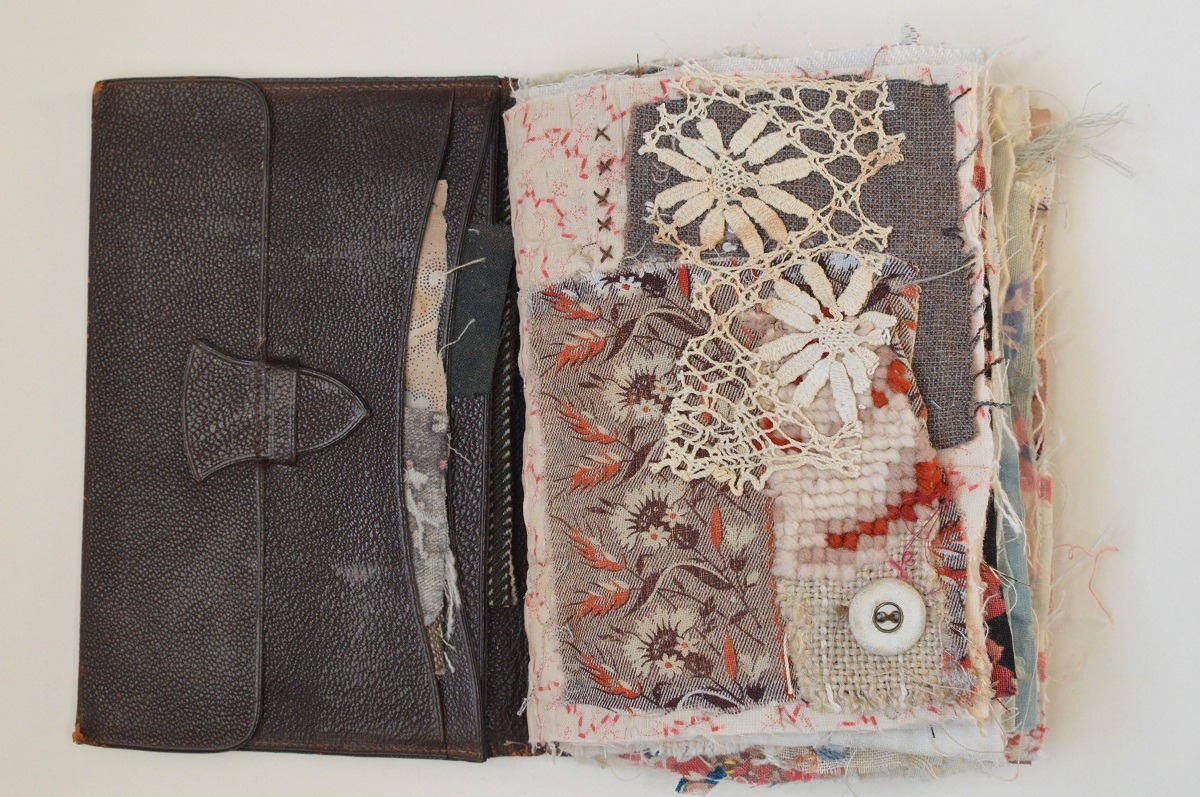
A book-lover’s dream
How did the idea for your Wallet Book come about?
Mandy Pattullo: I am an avid reader and I live in a house filled with books. Even with my busy life I manage to read a novel every week and have non-fiction and short stories on the go all the time too. I was brought up in a household where books and reading for entertainment and knowledge were valued. I am ashamed to say that sometimes we used read through meal times and secretly I would like to do that even now!
I love how novels conjure up a little world which you are plunged into. Stories are not all about the narrative drive but about allowing the reader to use their imagination and conjure up colour, texture and context around the characters.
The time-worn textiles I collect also have their own stories and life. When I mix them up a kind of magic occurs. I see my colour stories and collages like the collage of different elements that a writer brings to the page using words.
This link between vintage fabrics and their stories led to me making fabric books. They are not about the words but still ‘speak’ to the viewer. They tell a story about a project I might have been working on. In fact, they are usually made at the end of a project using tiny left-over scraps.
My inspiration started with seeing the Bronte Juvenilia, children’s tiny little books, at Haworth parsonage. I really coveted them and recognised their preciousness and want people to feel the same way about mine. The Bronte Juvenilia are unique one-off productions. I like the idea of this; the fact they are irreproducible.
I also love Louise Bourgeois’ textile books and those big ledgers that you sometimes see at Antique Textile Fairs that are full of little samples of fabrics.
I have a large collection of artists’ books from all over the world and they have influenced the physical ways that I have put fabric books together over the years. My books might be bound Japanese-style or with a simple pamphlet stitch. They might take the form of a scroll or a concertina. Or echo the rag or quilted books made for babies.
The feel of the book in your hand is very important, which is why I started using old leather wallets as book covers. There was a sense of them having been used many times in a past life and possibly held in a pocket close to the heart.
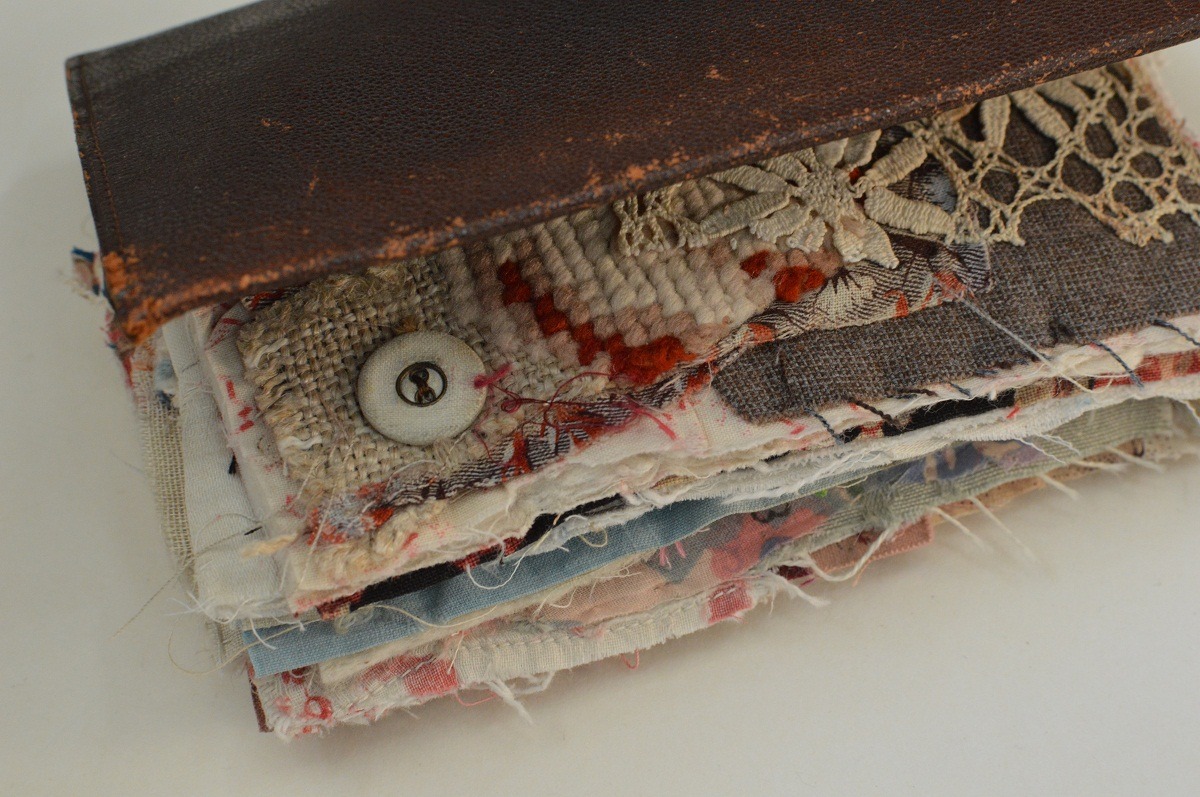
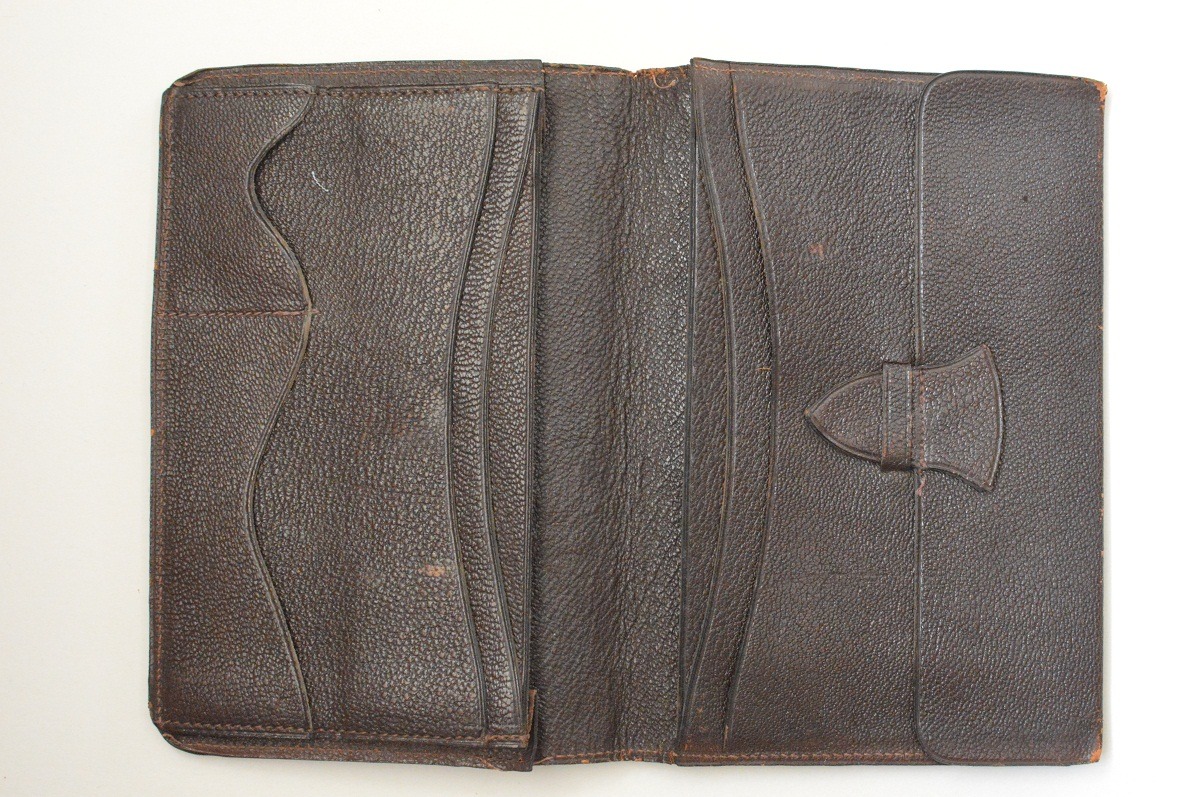
A box of delights
Was there any other preparatory work?
I don’t do any research for a book project like this. They grow out of other projects that I have on the go.
The books are made as a sideline to another project I am working on. They are instinctive and self-indulgent pieces.
Sometimes I have collected so many scraps left from other projects that I just have to use them! Because of this, my preparation simply involves sorting through my scraps and partially-worked pieces to decide what to incorporate.
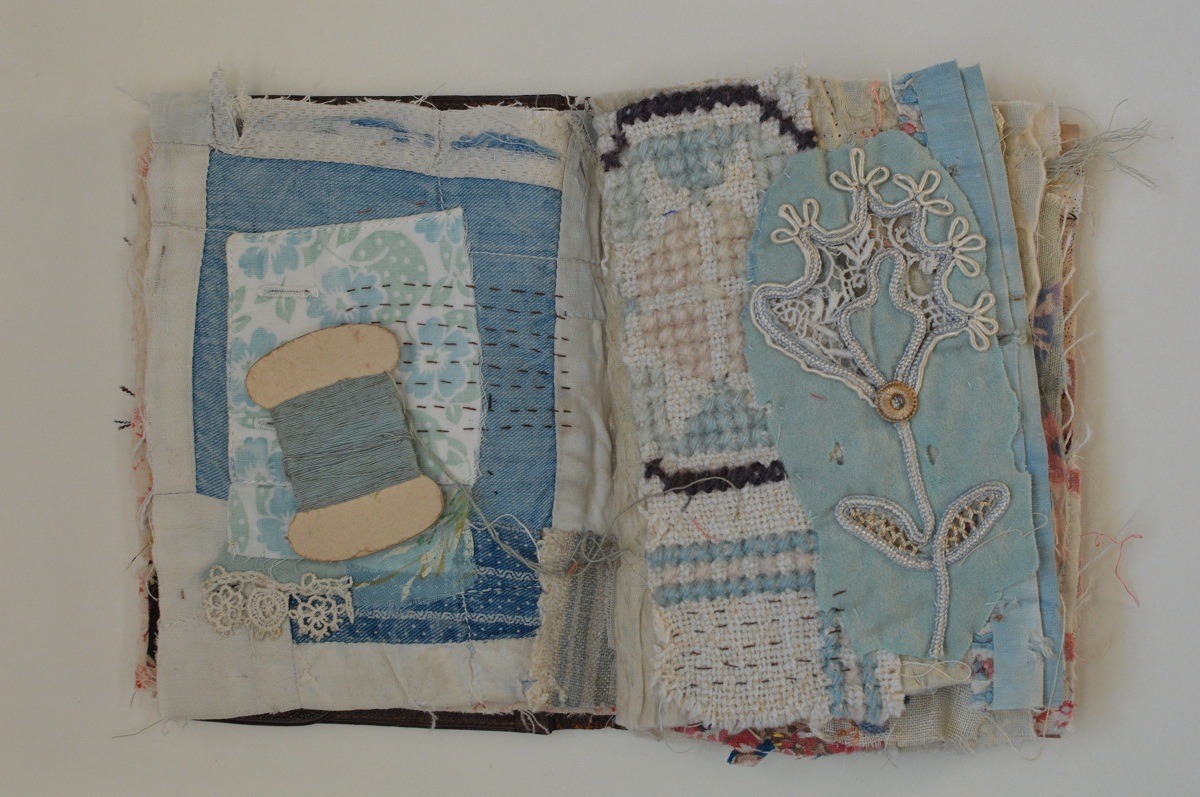
What materials were used to make the book?
The materials are what it is all about.
I have been collecting antique and vintage fabrics for years from charity shops, vintage and antique fairs and from markets in France. I don’t buy any materials online as this seems too easy, somehow. I love the thrill of finding things myself.
My studio is located in a building that is open to the public all the time, and people often bring me little bits of fabric that they think I can use.
I especially like to use pieces of old quilt. These can be fragments of patchwork or pieces of whole cloth quilt that I have unpicked. I end up with a pile of thin layers with the shadows of the original stitch prickings on the surface.
I often use the back of the fabric piece rather than the front. I also use a lot of pieces of old embroidery, precious items mostly sourced from fairs run by The Textile Society or from charity shops.
Here in the North East of the UK, I can find vintage quilts quite easily. If you can’t find source material then eBay or Etsy often have sellers who sell small pieces at reasonable prices.
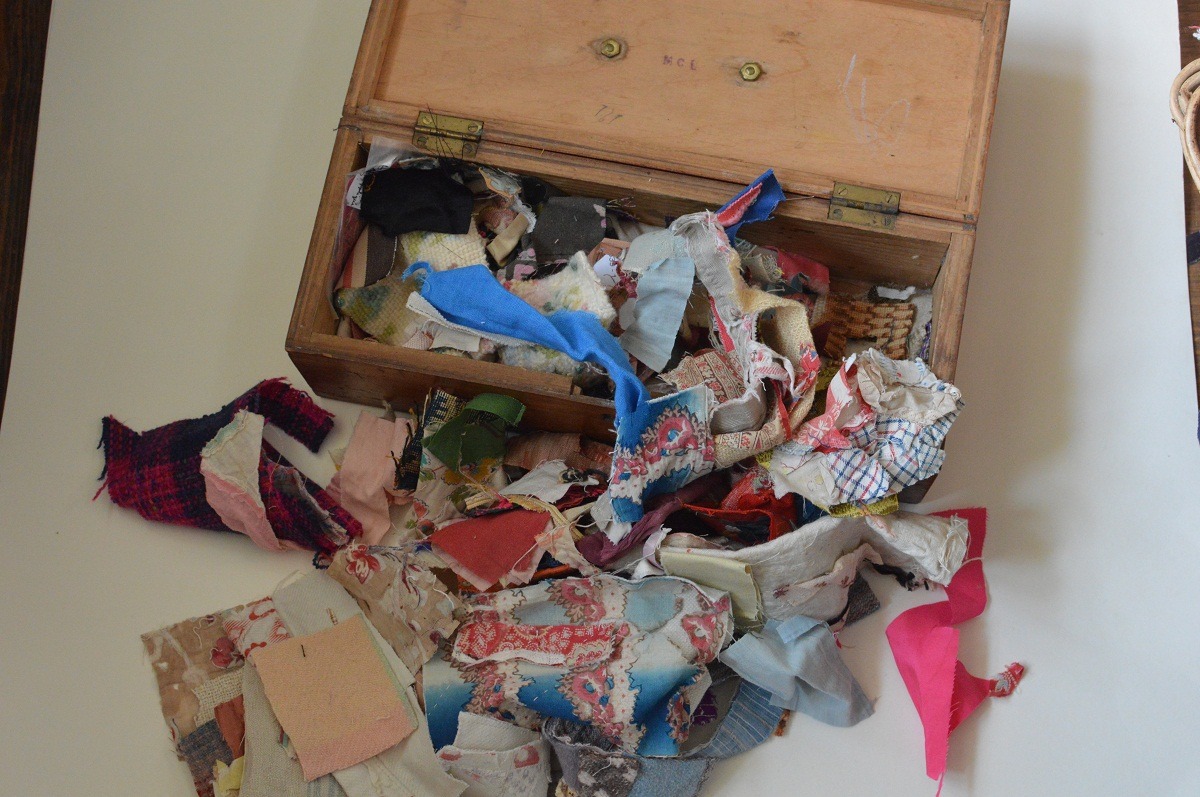
What equipment did you use to create the book?
These rag books are very low-tech. All I need is a pair of scissors, pins, a needle and threads and a pile of old fabrics. If I can’t find an old wallet then I improvise and make a fabric cover or use a piece of blanket or quilt.
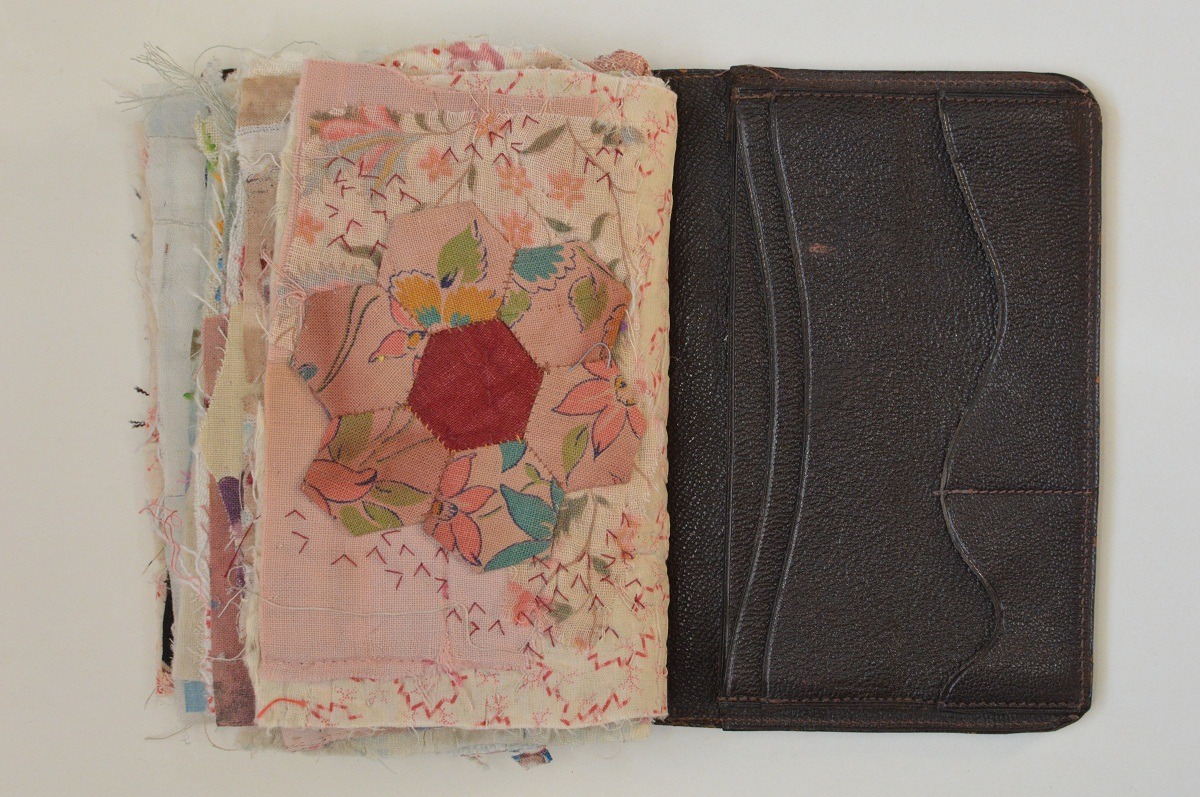
Collages of colour
How do you make the book pages?
First I cut double-page spreads to a size which will fit inside the perimeter of the leather case. I tend to cut more than I need. For this book, I used three different pieces of quilt. Other alternatives could be a wool blanket or any other firm fabric.
Once folded, three double-page spreads will create twelve ‘pages’. With a thinner foundation fabric, I would increase this to four folded pages.
I want the book to be enticing so a bit of bulkiness is acceptable, but I have to make sure the pages can fold.
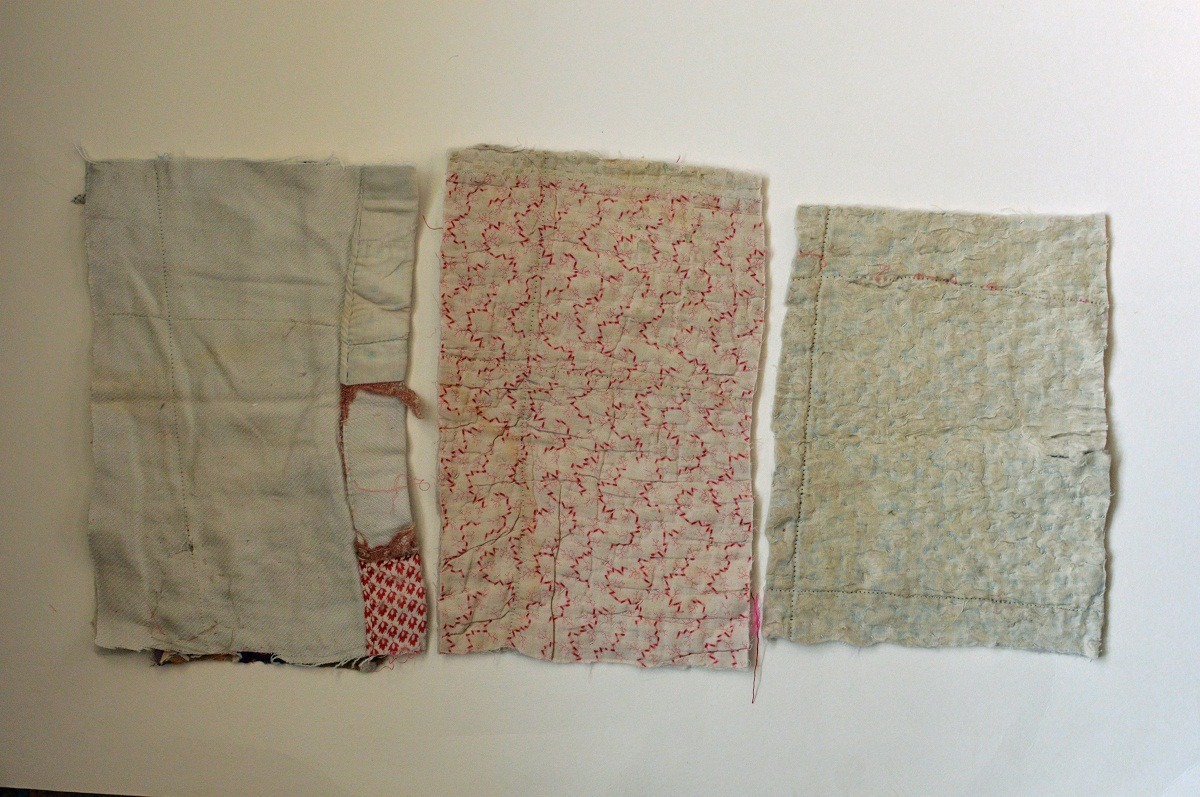
How do you decide which fabric scraps to use?
I simply start to delve into the fabrics. I sort them and lay out little colour compositions on to the top of the pages.
As the pages are interleaved I need to bear this in mind when building up the compositions for each page. Two of the foundation pieces might have four ideas for collage and then the other foundation piece will be the middle page spread.
These piles of scraps may not be what I will use in the end. They just get me started. Some elements will be added or taken away from the initial colour stories I group together.
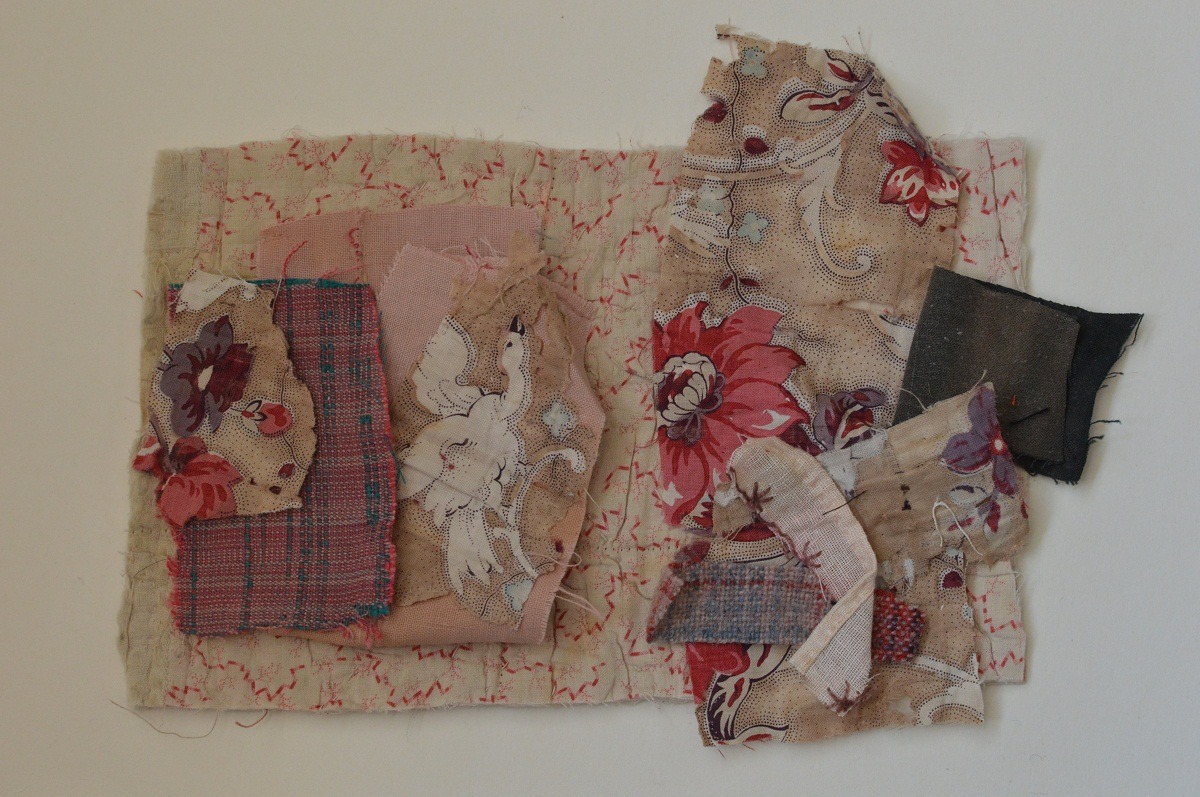
What is your process for compiling each page?
I start to cut, pin and organise. As I do this I play with interleaving the three quilt foundations so that I can see how things fall next to each other. Deciding on the composition is purely instinctive, but generally I try to leave an open area on each page where I can add embroidery stitches.
I often choose one very interesting piece of embroidery or fabric fragment to be the central focus of the piece.
I turn over the pages and do the same on the reverse side, pinning elements in that seem to speak to each other.
My aim is to concentrate on getting a good first and last page. I also plan a strong middle page spread, as that is where the book will fall open naturally. It might take me a whole day of pinning and rearranging to get the elements right. I tend to leave it and come back the next day to re-evaluate with a fresh eye.
When everything is right, I trim some of the inner pages a little so that the folded pages line up nicely. Then I start stitching all the elements onto the pages.
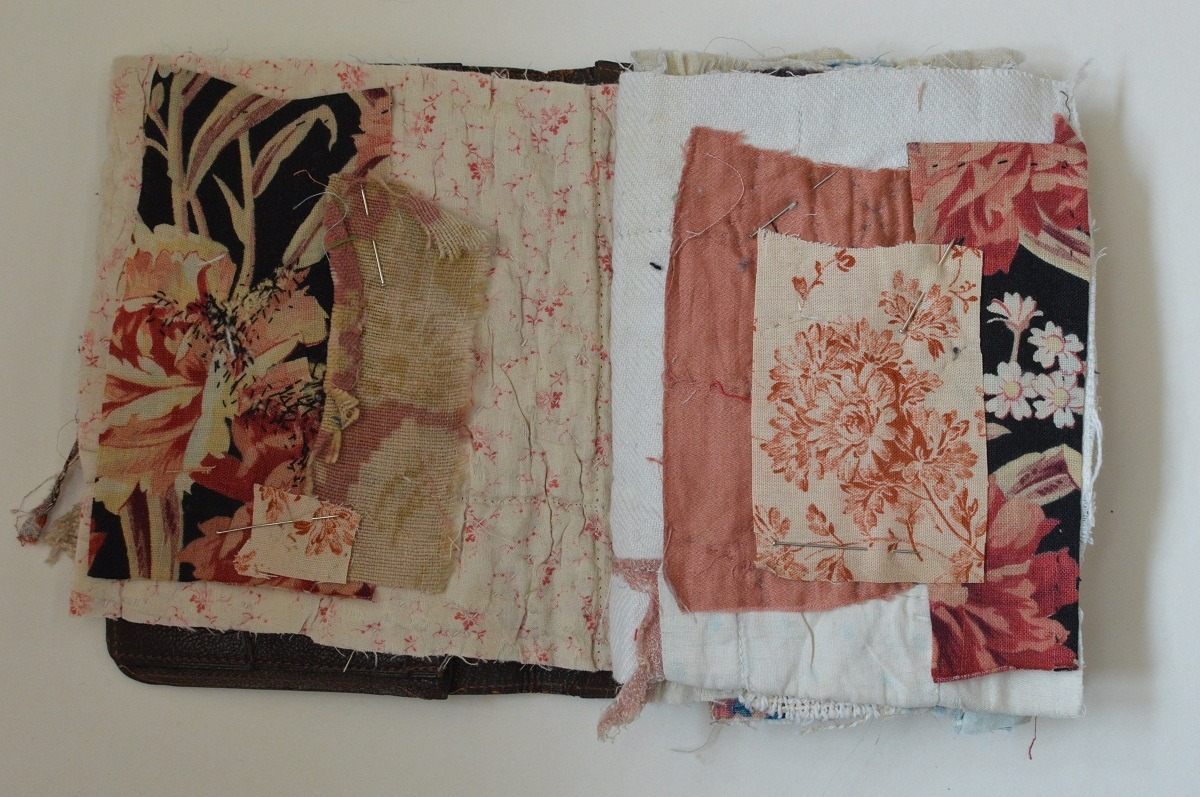
Which stitches do you use?
My aim is to sink the stitches into the blanket or quilt so they cannot be seen on the reverse side. I use a tiny overcast stitch, which goes over the edge of the fragment I am attaching, or sometimes a tiny stab stitch just inside the edge of the fabric.
When everything is attached, I add some embroidery stitches. These are fairly minimal but they do add further surface interest.
I am often led by the fabrics, so if there is a stripe it might suggest lines of running stitch. If there is a ditsy print I might use a scatter stitch like seed stitch, fern stitch or french knots.
I look for the spaces in between the various elements on the page. Any empty areas may need an extra bit of mark-making with stitch, to add extra interest.
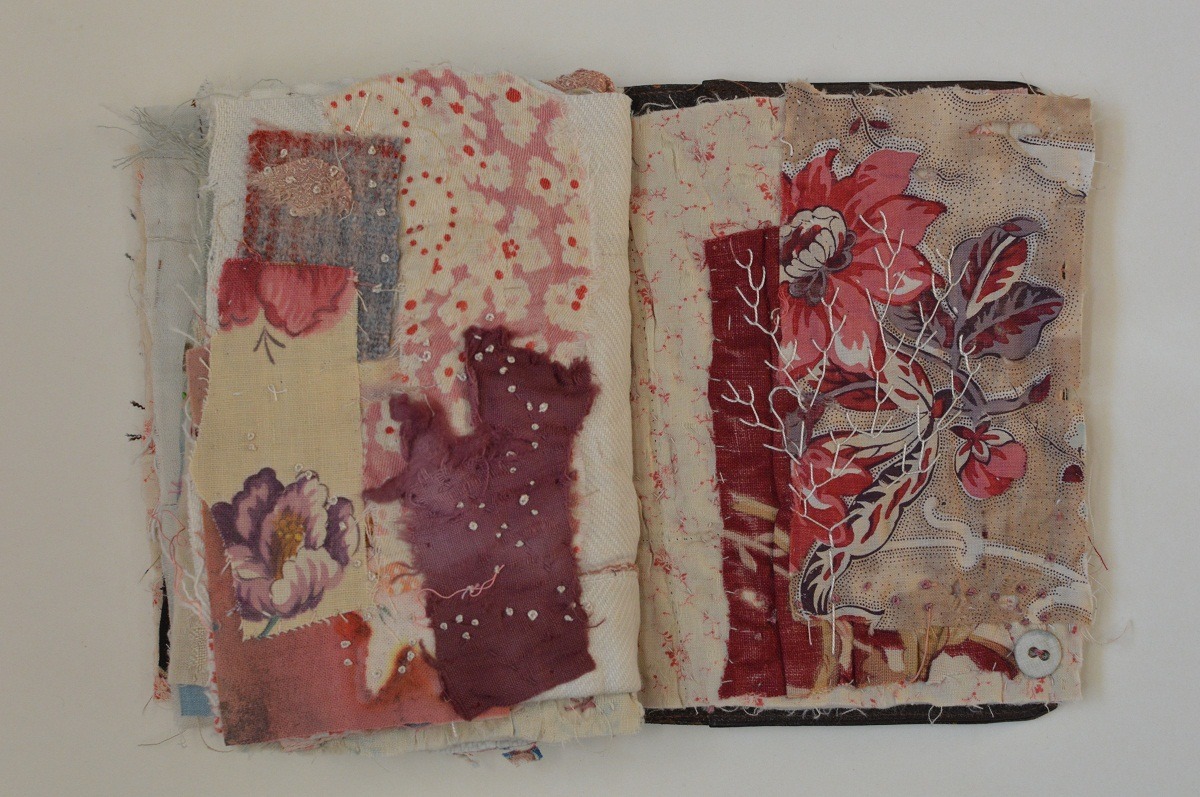
How do you bind the book pages?
The final task is to sew the book together.
This is done through the middle of the double page spread. I use pamphlet stitch but you could just do a running stitch up the middle.
I use a bulldog clip to keep the pages together while I am sewing.
If I use pamphlet stitch then I leave the ends hanging from the middle. This allows further scope for embellishment with beads and buttons, or sometime I attach an old lace bobbin to these hanging threads.
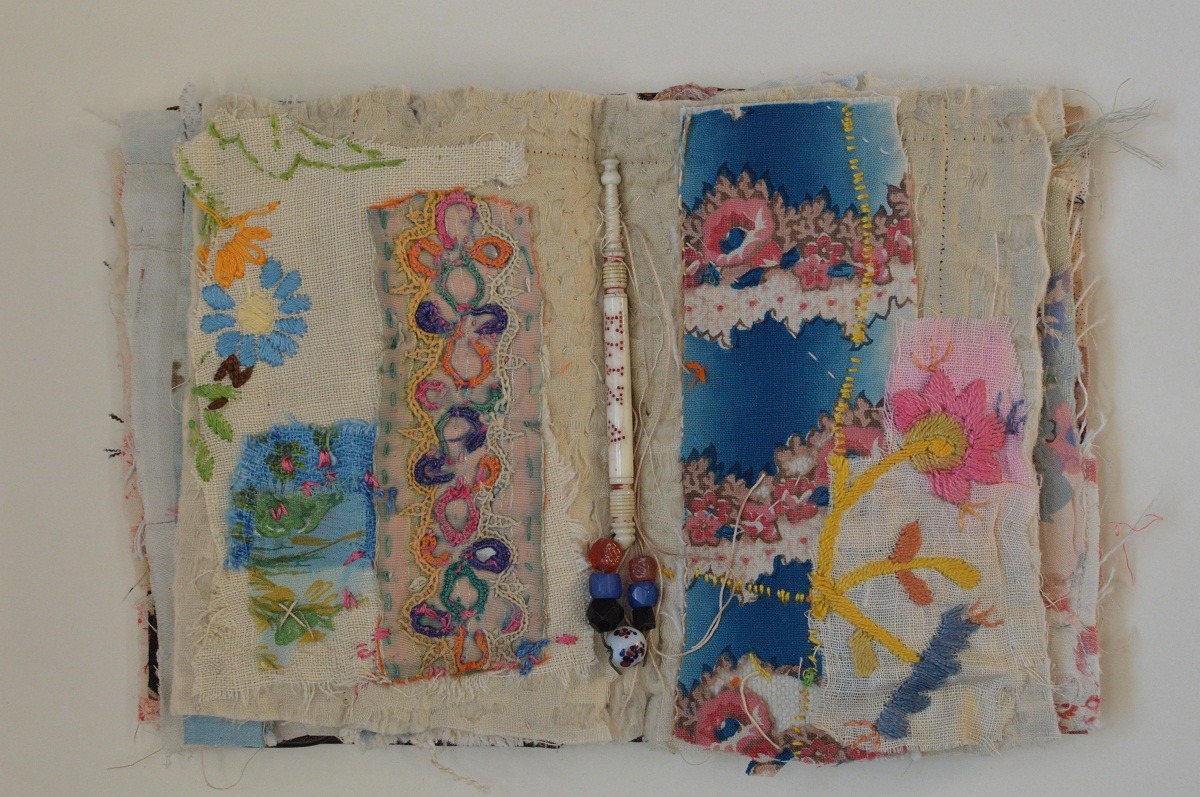
Do you show your fabric books, or are they purely for your personal enjoyment?
This work will not go on any journeys as it is too precious to me. However, I often put out a display of my fabric books for visitors to see at my Open Studio events. I also take my collection of books to workshops. It inspires others to use those tiny little precious scraps in a creative way.
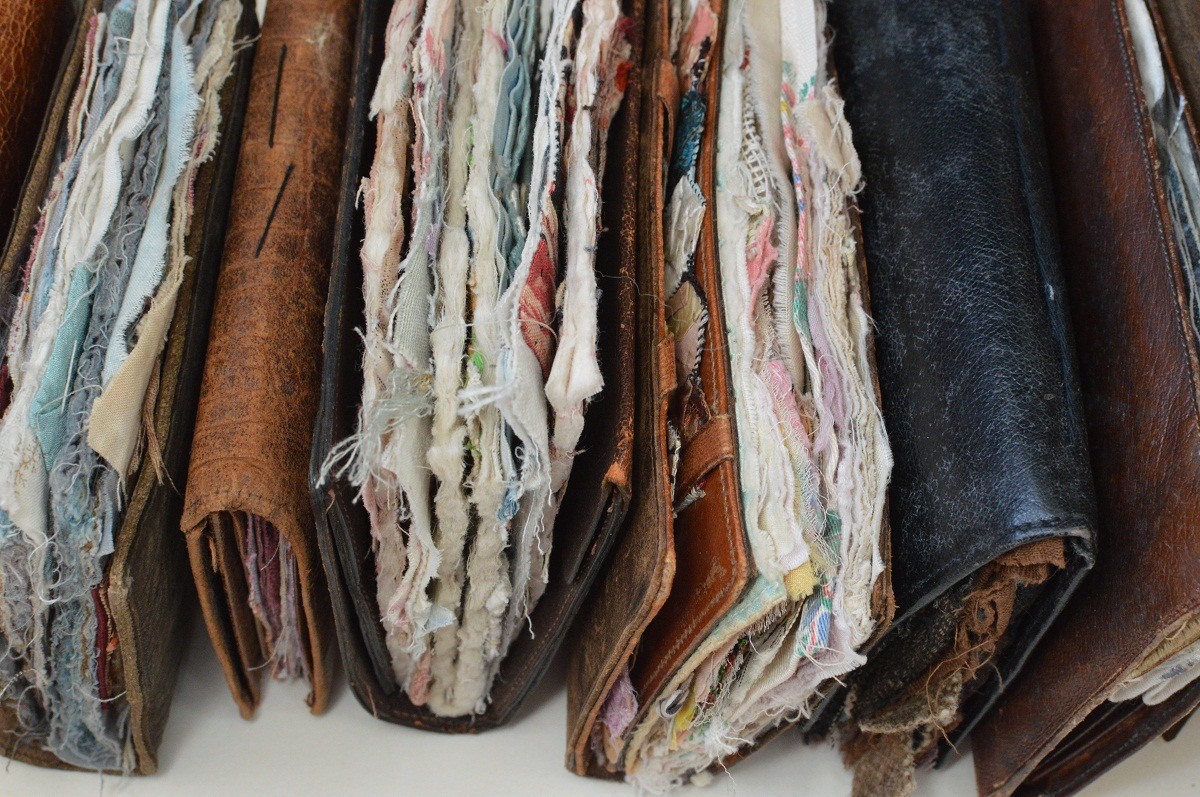
Mandy Pattullo is a textile artist based in Northumberland. Her work is based on references to historical textiles and traditional techniques.
After spending many years teaching in an art college, Mandy turned her focus to her creative practice. She explores the importance of local folk traditions and sewing generated in domestic settings. She teaches workshops both nationally and internationally, and is a member of The Textile Study Group.
Artist website: www.mandypattullo.co.uk
Instagram: @mandypattullo
Do you save your left-over fabric scraps from other projects? Let us know your ideas for re-purposing waste fabric, by leaving a comment.
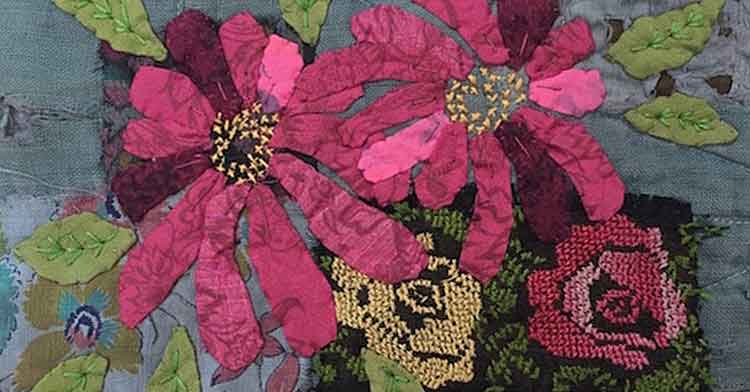
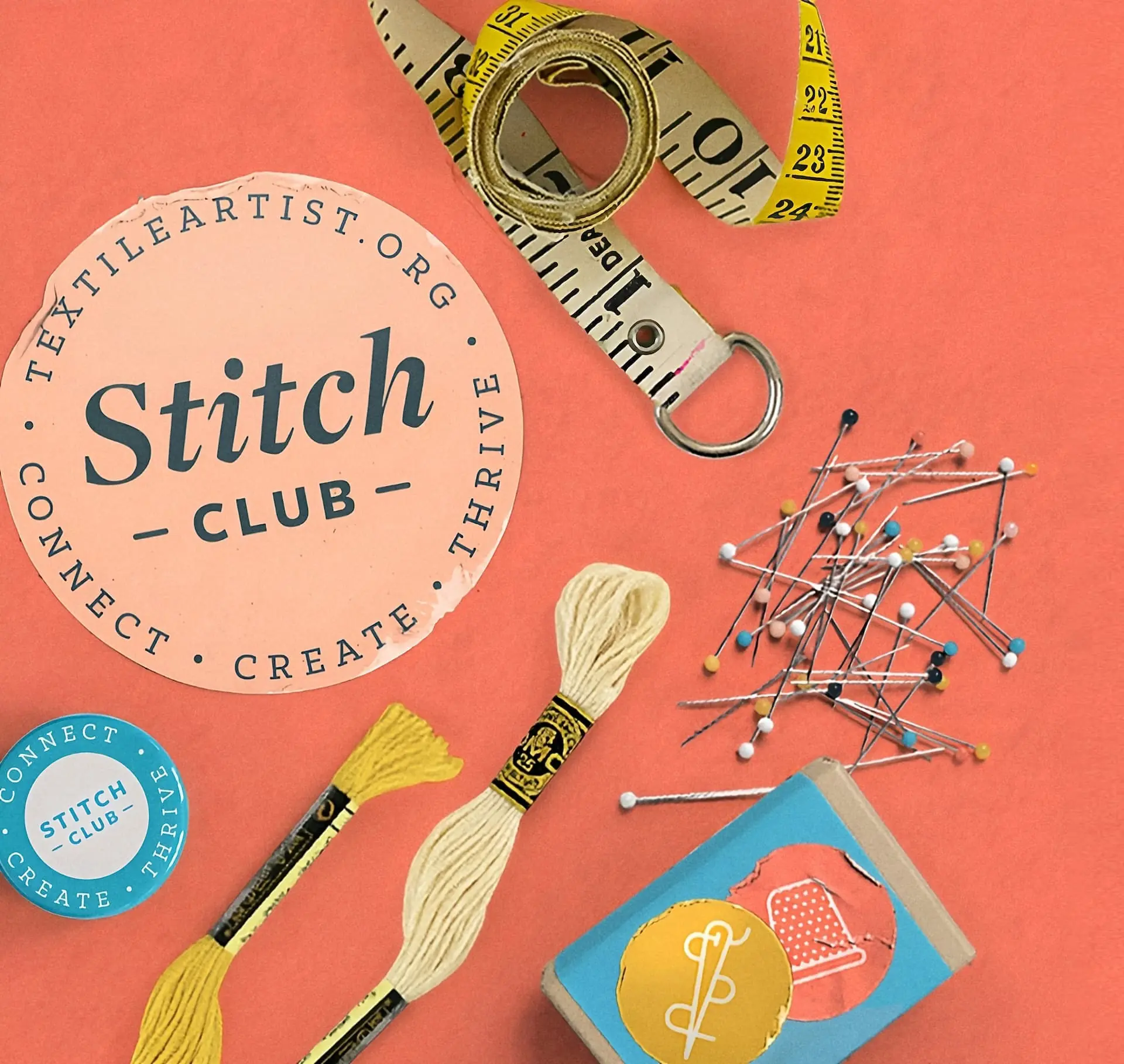
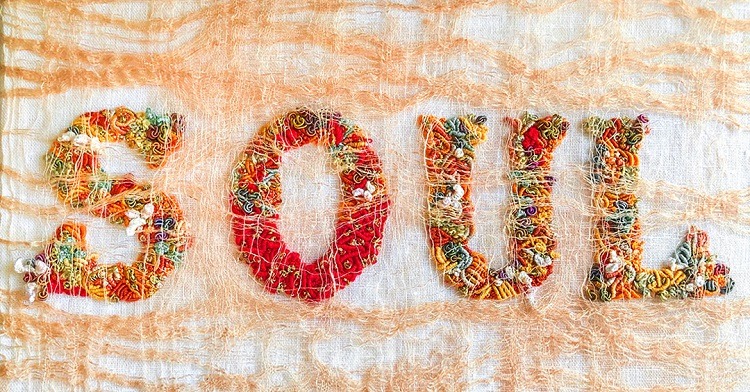
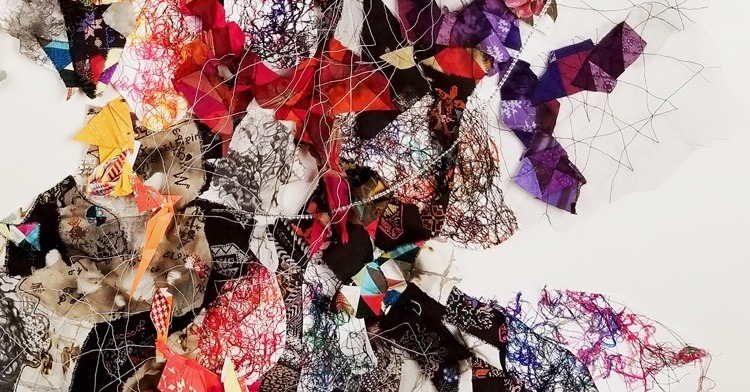
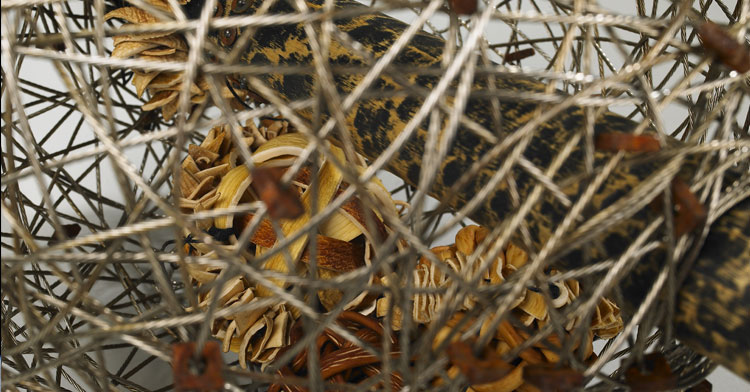
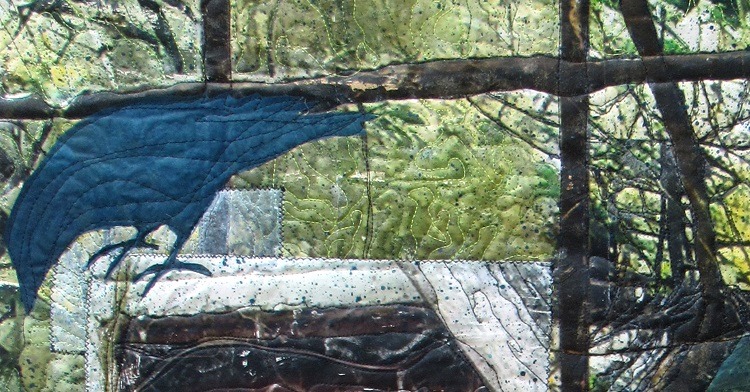
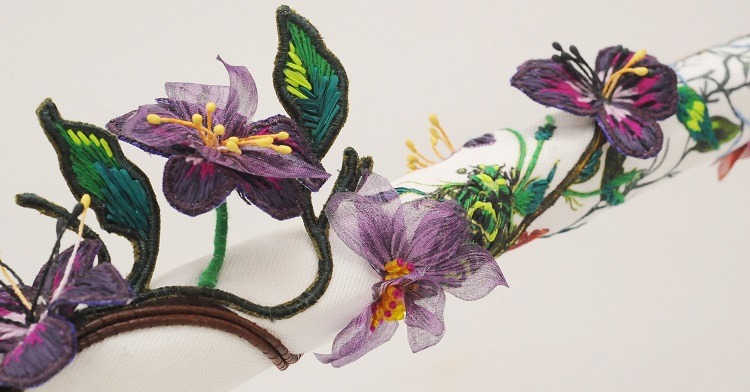
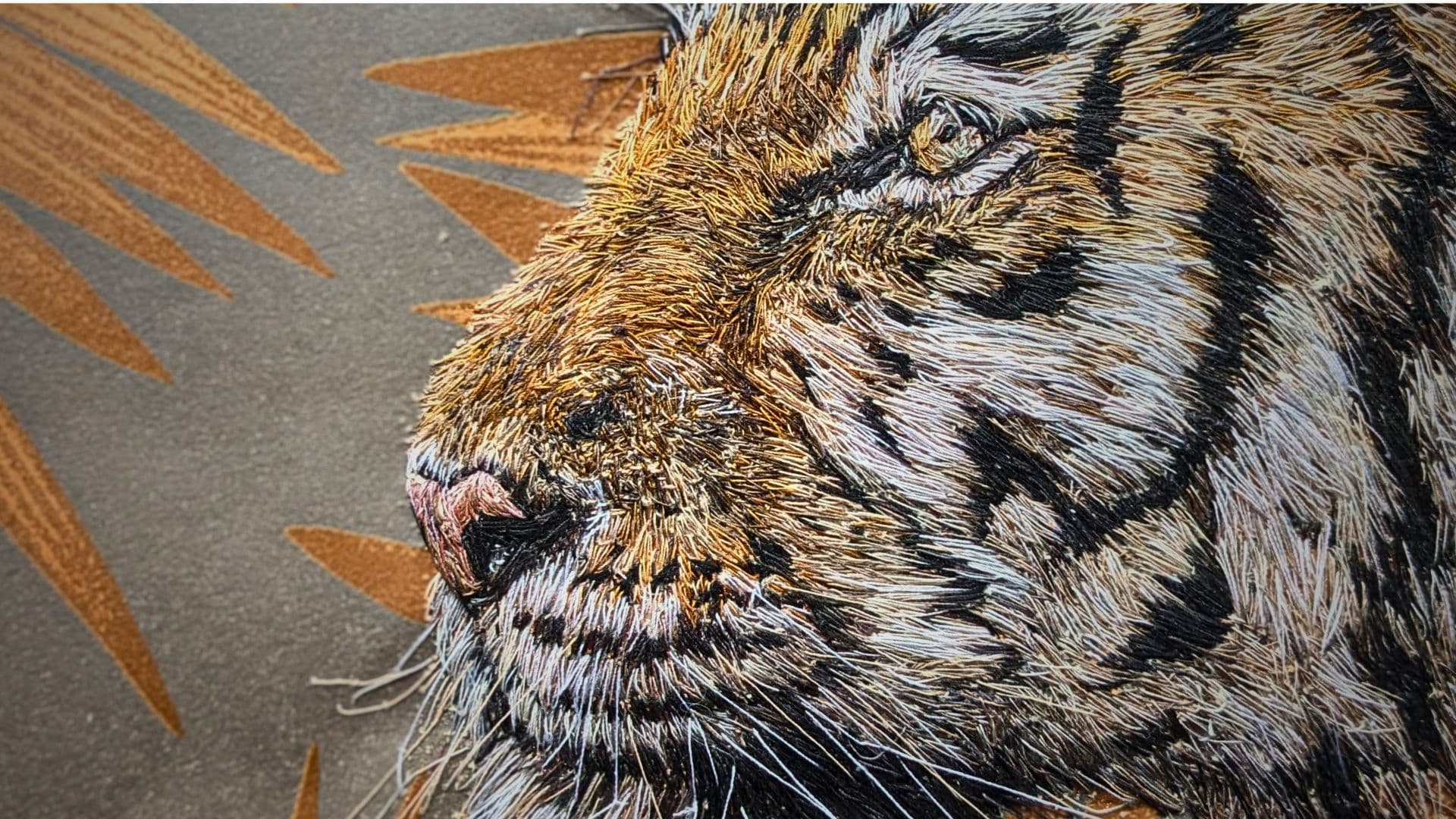
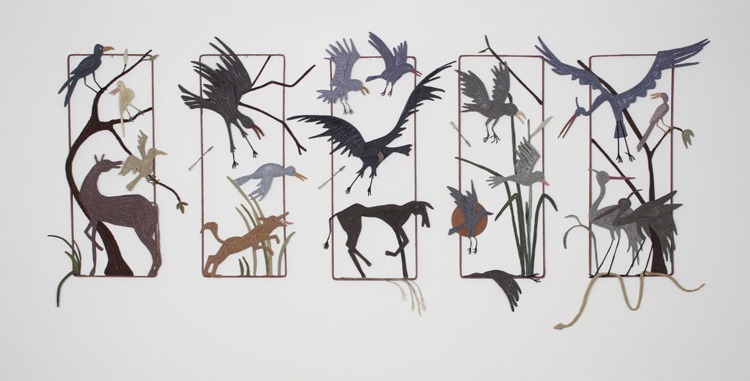
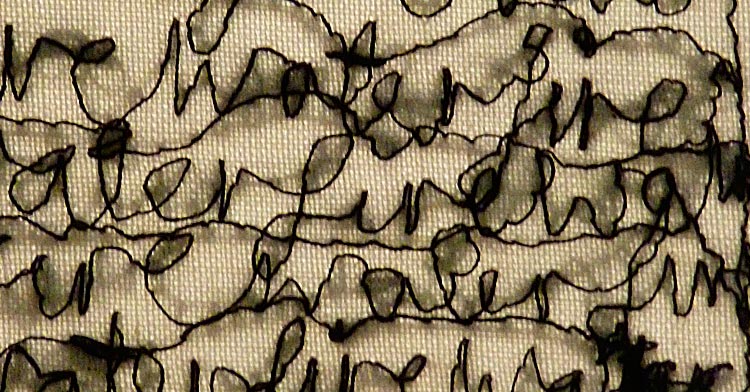
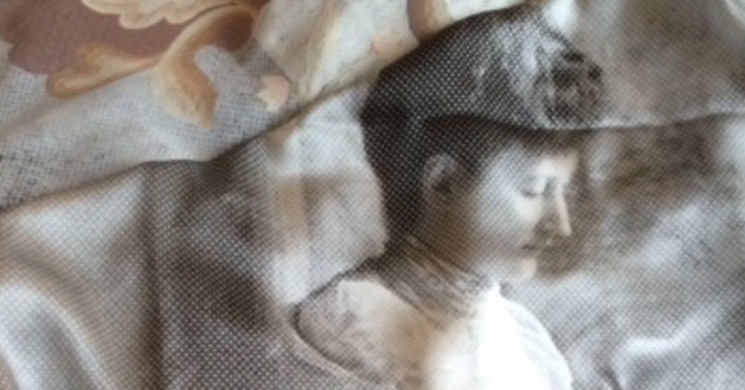
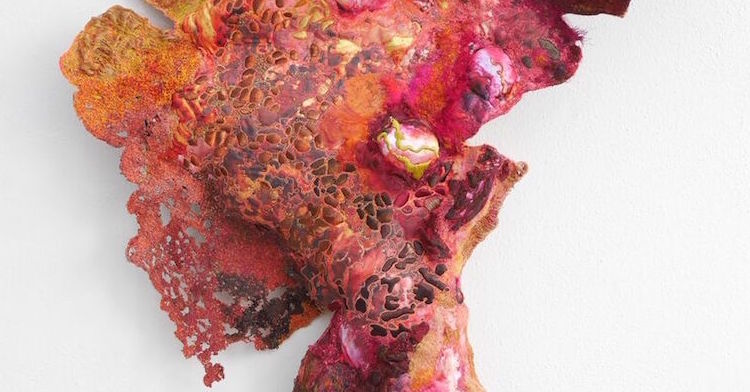
39 comments
Eugenia
Es l a primera ve que veo sus trabajo y me encantaron. Son hermosos. La técnica me atrapó.
yolanda farana
Hi, i stumbled on your book at the local library and checked it out so many times just cause i love the pictures and textile art you did. I love to slow stitch and do fabric hearts with lots of embellishments. But I fell in love with your idea of using my left-over fabric to make or try to make a fabric book. I’m stuck on how to put it together. Like the binding. I have a lot of used leather empty wallets but have no idea how to incorporate the fabric pages I’ve done. Im hoping to take a chance and just do it how i think it can work. Id love to have your simple if there is one on how to put it together. Thank you.
Or perhaps i need to take your textile course. Thank you for your inspirations.
USA
LT
Jessica Giasullo
Mandy, thank you so much for sharing your process in creating this exceptionally lovely and interesting piece of art. I had seen the piece before and enjoyed it so much. I kept returning to it after looking at other fabric works. I was so thrilled to see how it was first born and evolved.
Jessica
Orcas Island WA
USA
Pagan
I love these books, they are so tactile.
I use up other people’s scraps and my boys seen better days clothes and make patched jeans that have embellishments and political statements I embroider onto them, so I am a walking canvas
Anne Swinson Godwin
Thanks for sharing so many different artists. Thanks, also for only showcasing two or three in each email. So much inspiration!
Arlette Schulman
Mandy…….you made my day worthwhile by inspiring me totally. As a huge coincidence, yesterday my daughter was visiting me, and she opened a drawer where all sorts of things end up living there, and pulled out a very old wallet which I could not throw out….my favourite and irreplaceable! What a unique coincidence. I am a textile artist for quite a few decades.
A million thanks for sharing and inspiring me. Arlette
shirley
What get to my heart is the amount of differences, the”eye” to see the beauty in the littlest scrap. I do keep my scraps, I look at them and sometimes I do make crumb blocks and incorporate them in a quilt. Not had that “eye” yet, but I keep looking.
Lesley
I too have been inspired by Mandy’s creations and have longed to go on one of her workshops. Thanks for sharing more details on her creative process.
Pivoine
A lot of inspiration! Very very interesting! i have so many bits of fabric, i know what to do with them now. Thank you Mandy for sharing your ideas. (I like also that idea of wallet!)
Anna
Hello. wonderful work.
thank you for sharing.
I have a wallet like that leather one that I could use to make one like yours.
I have been making fabric memory books for a long time using doilies and old vintage tablecloth and scraps and yarn buttons etc, stitches sometimes I zigzag on the sewing machine and other times by hand and I always have a pocket on the page to put something memorable in it. I try to make the book in favourite colours of the people I am thinking about.
they make wonderful gifts for women who love textiles.
I put a tapestry fabric on the outside sewing together like a book and put a ribbon and a button around it to tie it all together.
Amir Mohtashemi
Quite a beautiful work “Mandy”. I love the idea and thanks for sharing the details.
Linda powell
Very inspiring. As a fashion pattern and clothes maker I collage scraps together into other garments. Or use as surface appliqué. My scraps are never quite so small. A mix of art and fashion. Because of this I have stopped buying fabric tho on occasion I am gifted some. I am now looking at knitting n crocheting fabric.
Insta @lindapowellpatterncutting
Heather DeGrandi
I love Mandy’s work and your article was an inspiration. Using old wallets for book covers, what a great idea!
Can’t stop collecting old bits of fabric now. My book shelf is growing with fabric books. Thank you, Mandy.
Sheryl Kessler
I love Ms. Pattullo’s work! Her book is what inspired me to start fabric collage. I save EVERYTHING and use it in collage with embroidery, and now weaving. My friend gives me all of her quilting strings and scraps as well. I am always trying to figure out what to do with this stuff as I also save snips of embroidery thread. The birds around my house don’t want it–I just took back scraps that were in a clean suet feeder for a year and wove them into a tapestry. I barely touch my extensive fabric stash.
Suzanne Coley
Thank you for this article and the wonderful work Mandy is creating. I love making textile books and learning how others use textiles in their work. Salvaged wedding dresses and vintage gowns are the main materials for my current textile books. Marrying the book form to textiles as page material, elegantly argues that fabric doesn’t just have to be wearable, but that it too has stories to tell and a past worth sharing. The history and stories behind the vintage textiles and wedding dresses are essential components of my handmade books.
Again, thank you!
Lee
I loved reading this since I have played with the idea of making notebook covers with my smaller scraps of fabric. Almost ashamed to say I got rid of the smallest scraps. Long time agou I used to make dolls clothes but never saw a use for the tiny pieces left over … until now. The 2 scandinavians Arne & Carlos has also made me feel an itch with their craftbooks. Maybe it’s time to do something about it.
Love all inspiration, even when it doesn’t result in anything actually. Just the inspiration and the fantasy it triggers is sometimes enough.
pat cooper
I am currently using selvedges. We make feminine hygiene kits for Days for Girls so we generate a lot of longish selvedges. I have been weaving with these selvedges and mixing in some OMG yarn (OMG why did I buy that? yarn). I am working on “non-looms”, picture frames and cardboard boxes. I find that I am quite taken with the textures and the idea of “zero waste”. I plan to incorporate some surface pieces. We just did a “Fiber Bomb” at our Art Festival in Mission Texas (USA) and used the woven pieces as a backdrop for other worked fiber pieces which we used to try to explain Fiber Art.
Chris
Any chance you can post a photo of your selvedges pieces as they sound fascinating. Thanks.
Alice Abrash
I love this idea of making books from fabric scraps. I have made one or two myself, and I just enjoy turning the pages and enjoying the little bits of meaningful fabric all over again!
Alyson
I love this work!
Beverly Threadgill
Wonderful, creative way to make art from pieces! I have one of these old wallets and I have wondered what to do with it. My brain gears are turning! Thank you for the inspiration
Nancy Claiborne
I am fortunate enough to have one of Mandy’s pieces, a blackbird, that resides on my living room mantle shelf. Her lovely work is a constant inspiration and reminder of the value of things with a bit of age on them.
Karen Monteith
I try to use my scraps. I collage them creating pictures. I also make crumb and scrap quilts.
Diane Trasler
These are beautiful records of fabrics, embellishments, threads and leather wallets…I love this style do upcycling too.I think they are beautiful…well done Mandy.
shirley
interesting,i have learned so much from these posts. expanded my thinking on sewing as a whole.
Judy Gee.
What beautiful work. I recently made our dog a new mattress cover with lots of left over scraps. Not sure she appreciates the amount of time that went into it!!
Di Hayes
I have long been a fan of Mandy’s work. I collect and arrange fabric scraps and Kantha stitch over them. I just make squares of this work, or occasionally make a wall hanging with them. It is not the finished project that interests me; the process of making, creating patterns within patterns and the simple act of stitch is enough in itself.
Michèle
Merci Mandy pour ces explications, je rêve tellement de vous rencontrer , mais pour moi les cours à Château Dumas sont trop onéreux , peut être un jour ailleurs en France !?
Jackie T
I’m off to tip all my colour coded bags of bits into a large tub – I think the concept of serendipity could re-ignite everything – Thank you.
Kathryn Elliott
A really inspiring article -I’m going to start looking out for used materials and use them in small collages to begin with .
Thameena
wow I really like this style of textile art, it is a very pretty, girlyish sort of piece with a vintage feel!
Béatrice
Wonderful, thanks for sharing your process.
Chris
A great profile of how artists recycle the world!
Ellen Finan
I appreciate the role of serendipity and reflection in the execution of your pieces– creating the “freshness” of your piece. Your description of how you go about creating honors the history of the cloth as well. Thank you!
SheilasEmbroidery
Thank you for sharing this piece of work from our local NE textile artist. This is a lovely piece and Mandy’s story is inspirational.
Lori Kay
Beautiful. Thanks for sharing this featuring Mandy Pattullo on your website. I’m off to explore more of what you have to offer!
Karen
This is a great article. Thank you Mandy for showing us your process. I can’t wait for your book to become available!
Lynn Somerstein
I love the generous and specific description of process, as well as the beautiful results.
Johanna
Enjoyed seeing the process of your piece! Your artwork is wonderful – thank you for sharing!